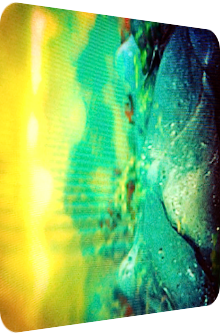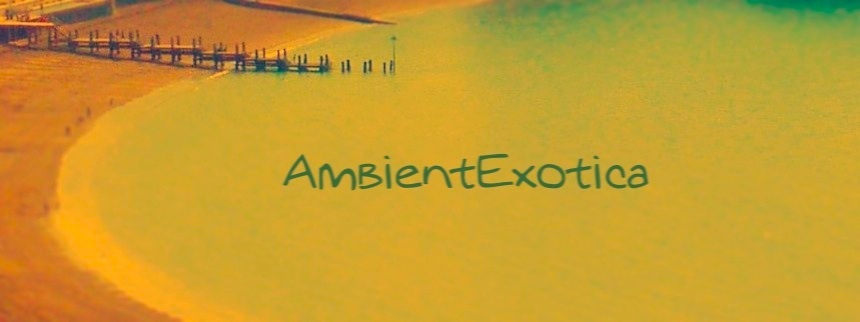
Riot Meadows
Natural Circuitry
2013
Hailing from Lake Geneva, Wisconsin, Steve Targo aka Riot Meadows has, for the time being, interwoven a conceptual arc into his music that sounds curious on paper at best, but turns shrugged shoulders into wide-eyed astonishment once a few seconds – any few seconds – of his Drone-based, Glitch-accentuated Ambient works reach the ears of potential listeners: the project Riot Meadows is actually about "sounds from a computer left alone in the woods, malfunctioning musically while nature slowly assimilates it." So far, so quasi-common. The realization of this dichotomous procedure with the implication of nature as the winning force to rule them all is as romantic as it is dignified, but believe me, Targo’s sounds can be fully enjoyed without this knowledge at the back of one's mind. Only here and there can old-fashioned transfigurations of mainframe sounds be heard, the rest is a blur… a magnanimous, magnificent mélange. This review is about Natural Circuitry – stylized by the artist as [N A T U R A L _ C I R C U I T R Y] – and the his first tape-based work, released in May 2013 on Matthew Barlow’s Asheville, North Carolina-based Twin Springs Tapes label in a limited edition of 40 cassettes as well as an unlimited digital download version. You can purchase Natural Circuitry and listen to its two tracks in full at Bandcamp.
Without giving away all too much in these opening paragraphs already, I can safely state that Targo's duo is a blissful blast. Ranging between 17 and 18 minutes, the compositions are loaded with soothing synth washes, heavily altered guitar strings, elastically bouncing bubbles as well as a reappearing wave-like structure of comprehensive capsules, huge caves plus groves and a pressing feeling of being swept away by the constant fluxion. Both tracks are intensely captivating, so much so that I only noticed the otherwise cleverly hidden structures of order during my fifth listening session or so. Supposedly freely flowing and independent of narrowing boundaries, Natural Circuitry is built on a framework and has a figurative spine of constancy. Read more about one of 2013’s most multifaceted releases that should not be missed and will stay with me indefinitely for sure. One last note regarding its intended audience, with absolutely no offense intended on my behalf: Natural Circuitry proves to be music for modern Ambient listeners with a short(er) attention span who want to be entertained by ever-rearranged sequences and move on to the next segue before the preceding one becomes vexatious, all the while an overarching theme is being grafted onto the track in order to keep an arbitrary randomness in check. So how does Riot Meadows construct this magnetism which seduces the listener so severely? A few answers come about below.
"No, you do not launch this release with a slow fade in, oh no! You will kick it off in medias res, with the dualistic fabrics already firmly in place." This could be the train of thought of Riot Meadows in terms of the cassette's first construction called 18:02, momentarily renamed Natural Circuitry (Part I) by me for the sake of convenience, as it is otherwise unnamed and simply reuses its time-related boundaries as the track title. Clocking in a bit over 18 minutes, the first contact comprises of a computer’s bleeping morse coils as envisioned in various Hollywood movies of the early 70’s. These are then placed in front of a vigorously wadded synth apparition of elysian ethereality which, coincidentally or not, interweaves that certain 80’s tonality and inflates it via deep bass ameliorations, helixes of hazy heliospheres and an enormously enchanting undulation of granular static noise particles with distant cyber gales illumined by an effervescent lucency. These structures glow, are intense, swallow the listener, let him or her submerge in the zeniths and protuberances of these billows. This is erethism entrapped in a sound file. Steve Targo could leave Part I at that, the wealth of surfaces would be sufficient enough for its entire runtime. However, after almost five minutes, the next segue is erected and marked by the means of thunderous electric bolts. The artist lets the wideness grow, the panorama becomes blazingly bright as if a veil is lifted at first, only to drape the exhilarative turmoil once again in the aftermath.
Whatever state this vignetted turmoil is in, the wave-like nature of Natural Circuitry (Part I) is its ubiquitous accompanist. The incessant intertwining of delicately aqueously-blurry drownscapes with the piercing sinews of frizzling whorls makes this mercurial first piece both blissfully spellbinding and resplendently inebriated. The third state sees Steve Targo concentrate on the bluer tinges of his self-created front artwork and injects an infusion of vesiculating oxygen blebs with scintillating synth stabs. Coated in an arcane superstructure of cavernous echoes and histrionic maelstroms of reverb, this very state does not paint a shallow sea rather than a shaken test tube that risks the danger of bursting at the seams. The final section hits the listener like a seraphic signal, crossfading with the diluted diorama and dehumidifying it with a celestial epicureanism supercharged with misty-mesmeric synth aortas whose frequency range grows into a fulminant finale: stretched supernovae, elasticized essences, powerful paradigms clash for an acroamatic apotheosis. What remains is a crepuscular stokehold drone coated in twilight, the primordial soup and base frame of this ever-changing entity of 18 minutes. The colors may have vanished, a rather bleak and dreary lingering sound established, but nothing can stop me from revisiting this polylayered monstrosity time and again. Listeners who are in search for an entertaining Ambient tune with a quick succession of different locations while still claiming a noteworthy share of cohesion, Natural Circuitry (Part I) is one of the top picks in this regard.
The second composition is called 17:18 and yet again renamed Natural Circuitry (Part II) by me to better mark its complemental existence. It makes use of another conglomeration of coruscating cascades and offers, as lazy slackers would state, "more of the same." However, this is simply not true when one dives deeper into its shapeshifting strata, a process or procession rather which is enormously hard to achieve in a controlled form, for what has been true about Part I is not necessarily astute concerning Part II: the variety of Part I lures the listener into a zone out state which strictly speaking should not work due to the bustling soundscape and its endlessly morphing physiognomy. But Riot Meadows shrugs his shoulders, connives, abides and delivers. Part II, in contrast, reserves much of its duration to deliver a driftscape which is maintained for over six and a half minutes. Opening with a liquedous globule of submarinesque proportions, the prelude of Part II is otherwise keen on delivering something that has not been featured heretofore, namely cherubic contemplations of the forsaken kinds, with synth choirs yearning in threnody. Curiously lofty, minimal at large and malevolently weathered, this post-apocalyptic exposition is unique in the given prospect of this tape. And it only lasts roundabout 90 seconds, for occasional airflows of bass drones wind up the much needed plasticity. All of a sudden, threnody changes to lachrymosity, irreverence becomes incandescence (or was that iridescence?), the analogue synth spirals reciprocate between mildly-acidic complexions and a sun-dappled allure, changing their colors from a bright yellow to an equally inspirational auroral lilac.
More than six minutes into this coral grove, a clear cut progression takes place. Galactic goblet drums, quirky stardust shards and vibrating sirens coalesce before a background of nullity whose vacuousness allows for a great interplay between the afterglow of the reverberation and the persistent phosphorescence. This vaulted ambience can only be aggregated under one genre name: Glitch. Notwithstanding the omission of truly digital jitters and splinters of the highest of all frequencies, this phase is a joy in hatched colors, presenting a shrapnel of rotor-esque staccato sparklers. This legato-less interim stage turns out to be a boon, as it allows the listener to sense the capaciousness. In addition, the pristine circumambience is positively wonky because of the many traces of humor and winks in it. When howling wind gusts begin to cover the pitch-black pith, phase three is initialized. Sizzling blizzards and mellow synth tocsins clash like elemental forces. Luckily enough, fissures turn to crevasses and let in the first traces of balmy-polyphonous drone streams awash with gleaming light, the first ones after more than eleven minutes! The percolating susurration is nothing short of gargantuan, the rapturous fundament of sumptuous melodies works all the better after the semi-opaque obscurity that reigned heretofore. The synth strings slowly oscillate between various halftone steps, are perturbed and penetrated with post-processing effects and change their shapes time and again, eventually winding down in the distance despite their otherworldly rise.
Natural Circuitry is a fantastic release by one very talented Ambient musician to watch: Riot Meadows has a plan, there is no doubt about that, but the array and sequence of incidents feels wondrously contingent and adamantly fortuitous, and these feelings turn out to be positively enthralling: through happenstance and random occurrences, serendipity originates. Steve Targo is not only the creator of the microscopic melodies, the many analogue and digital surfaces as well as the patterns and textures, he also serves as the coxswain in that he connects the segues with each other by rowing through the flux. If you listen closely, you will notice that the seemingly haphazard fabrications are segmented into various divisions; I have counted four in Part I and three in Part II, but your mileage may vary. This metering is also my hopeless endeavor to graft a little sense of order onto the vortex of disarray that is Natural Circuitry. It is a release that does not want to be analyzed in such a way. It wants the listener. As a return service, it captures him or her and does not let him go, inviting him to reside in these constantly mutating, diversifying, altering structures.
Especially Part I sees Riot Meadows unleashing all the colors of the rainbow, a gluttonous wealth that can only be called overabundance. Drones, spaces and aftereffects merge into an astonishingly opulent thicket of spectacular proportions, there is always something going on in-between the cracks and chasms, the listener is hopelessly bedazzled, then overawed, finally cleverly outwit. Part II is the designedly slower, gentler and harmonious counterpart, laden with longer phases and less alatoric jumbles. Rest assured that both tunes draw from cavalcades of textures in order to overwhelm the listener without ever becoming gimmicky, everything is in its place for its own sake, not due to prowess or reasons of showcasing wizardry. On every rounded corner, in each riverbed and above all thermal heat-fueled mirages, multitudinous splinters, flecks and trickles deviate, distract and divert the helpless listener. And this state of helplessness is utterly welcome! It makes Riot Meadows' tape debut a sapphire that stands out from the crowded Drone releases which rely so intensely on blurriness that even the omnipresent occurrence of haze is itself mantled in haze. I do wholeheartedly recommend Natural Circuitry, and in whatever way the contact between Steve Targo and Twin Springs Tapes owner Matthew Barlow came about, the synergetic offspring sparkles. Natural Circuitry also sports two short bonus tracks which could even pass as micro versions of Steve Targo’s aesthetic viewpoint, as they draw great connections to the main body of the work, one of them even depicting the very first time the Wisconsinite ever played a flute. You won’t notice, mark my words.
Further listening and reading:
- Purchase and listen to Natural Circuitry in full at Bandcamp.
- Follow Riot Meadows and Twin Springs Tapes chief extraordinaire Matthew Barlow on Twitter: @rIOTmEADOWS and MattCBarlow.
Ambient Review 217: Riot Meadows – Natural Circuitry (2013). Originally published on May 15, 2013 at AmbientExotica.com.
